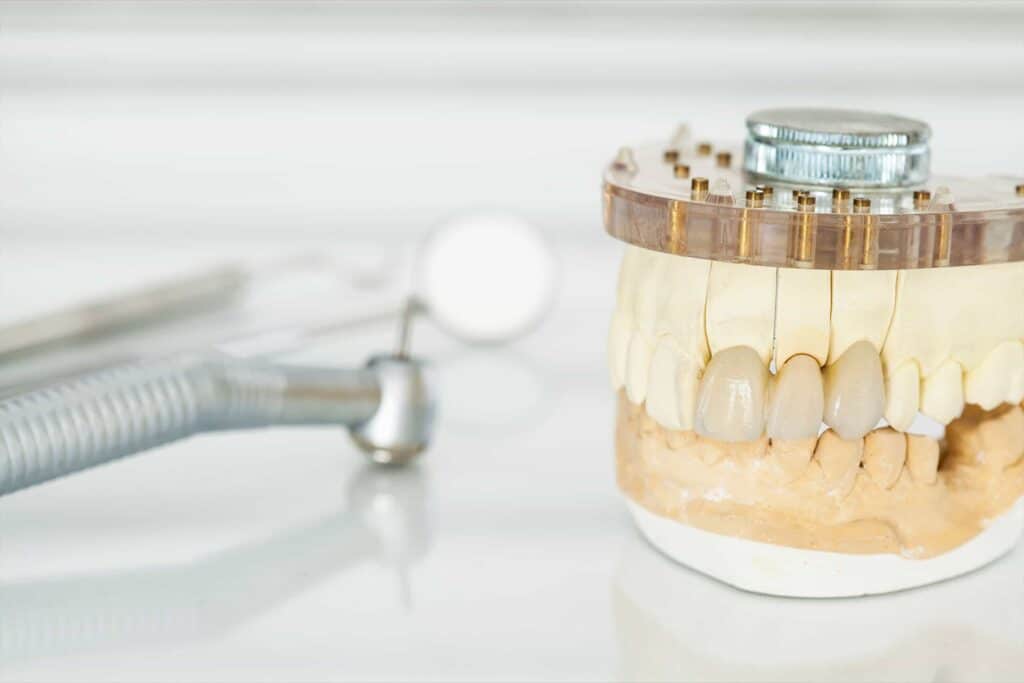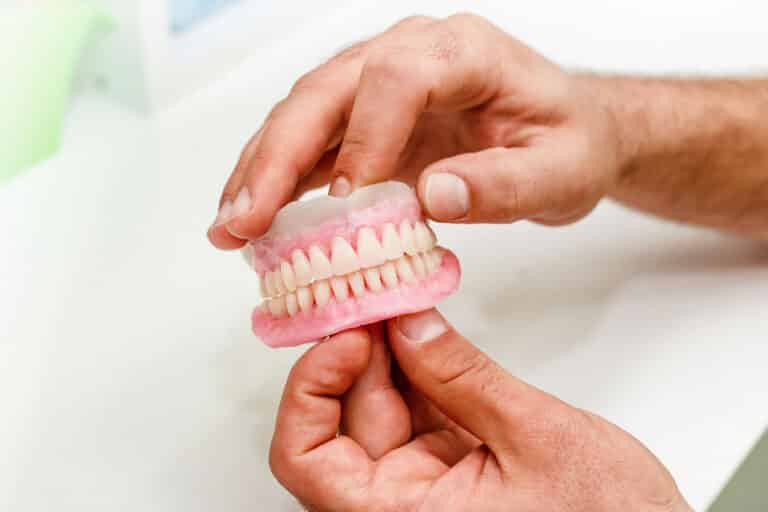A dental crown or dental cap is a tooth shaped hat that protects the underlying tooth when it’s weak due to a large filling, tooth decay, a root canal, or is a broken tooth. Ceramic crowns, also known as porcelain crowns, are dental crowns that are made up of one of several types of ceramics. They have a white appearance and are able to mimic the appearance of natural teeth very closely.
Many people choose ceramic dental crowns because they are more esthetic than metal crowns. As more people choose metal free dental materials, we may eventually see a phasing out of many traditional metal materials with perhaps the exception of gold crowns and titanium implants.
Initially introduced in the 18th century, feldspathic porcelain was used in anterior restorations and some posterior restorations1https://www.ncbi.nlm.nih.gov/pmc/articles/PMC5521757/. As time and technology progressed, different materials were introduced and continue to improve. Ceramic crown materials are no different, with recent generations having fantastic esthetics while protecting the underlying tooth.
ue to a combination of ideal physical properties, ceramics are widely used in dentistry today. Today, the most popular ceramic crowns used are porcelain fused to metal crowns (PFM), lithium disilicate (emax) crowns, and zirconia crowns.
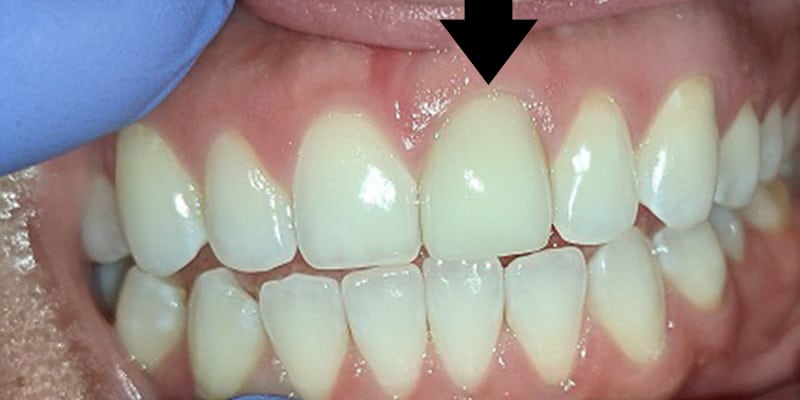
Porcelain Fused to Metal (PFM) Crowns
This older ceramic crown style is the only one type that is not completely metal free. Using a jacketing technique, the porcelain is fused to a metal substrate to give the crown a good blend between strength, durability, and esthetics. The idea at the time was to combine the best benefits of gold and all porcelain. The metal foundation is made of a combination of various alloys, similar to that of gold crowns.
Typically the metal is not visible, even when you smile, after it’s been cemented unless a metal collar is placed for optimal marginThe interface between a restoration and the tooth. This is the most common area for a cavity to reoccur on a tooth. adaptation. Once a very popular style of ceramic crown, PFM dental crowns are not used as frequently today due to the increased performance of other porcelain crowns.
Pros of PFM crowns
The logic behind porcelain fused to metal dental crowns is to blend the superior esthetics of ceramics with the strength of metal to get the best of both worlds. The first generations of a ceramic dental crown were not as durable as recent generations resulting in early failure.
By adding a ceramic shell to an underlying metal substrate, the PFM crown then becomes stronger than early fully ceramic crowns while blending in well with the surrounding teeth. Prior to the rise of other ceramics, PFM was the material of choice for front teeth. This is due to being a durable yet esthetic material, making it ideal for esthetic cases where strength is needed.
Cons of PFM crowns
Porcelain fused to metal dental crowns were widely used but the esthetics have always been subpar compared to fully ceramic crowns, even the older generations. This is mostly due to the metal substrate requiring an opaque layer which removes any translucency and makes the crown appear much more monochromatic compared to an natural teeth. While more natural looking than gold, it is still relatively easy for an untrained eye to pick it out the ceramic crown as not natural.
Additionally, the fusion of the porcelain to the metal may weaken over time resulting in fracturing. This may result in the necessity of replacing the crown as the fractured porcelain can lead to significant food impactionWhen food gets stuck in between teeth. This causes irritation in the gums and can be very uncomfortable., even if the metal base is still sealing out the margins.
For those with metal allergies, porcelain fused to metal dental crowns are not an option either which leaves an all ceramic crown as the only option. While a good option with front teeth, early generations of porcelain crowns are weaker than their counterparts which was more problematic with back teeth due to the increased chewing forces.
Lithium Disilicate
Also known as Emax, lithium disilicate is a widely used ceramic. This is due to the blend of strength, esthetics, and longevity, making it a very versatile material for crowns. Lithium disilicate is strong enough to be utilized as a full-coverage posterior restorationA synthetic material that replaces either part or the whole tooth that is missing due to disease or trauma.2https://synapse.koreamed.org/articles/1090006 and has been shown to have a high survival rate.
One such study showed a survival rate of 94.8% after 8 years of daily use3https://link.springer.com/article/10.1007/s00784-012-0700-x and there are many studies that validate the long-term use of lithium disilicate.
Emax is typically used in the anterior due to its translucency and optimal esthetics4https://www.sciencedirect.com/science/article/abs/pii/S1751616118302479 and is also a material that is able to be milled in office using computer-aided design, computer-aided milling (CADCAMAn acronym for ‘computer aided design computer aided milling’. This technology digitally designs and makes crowns out of various, large blocks of porcelain.) technology. This allows for the fabrication of crowns in a single day. Reducing the procedure visit to just one appointment can be very advantageous for those with a very limited schedule.
Pros of Lithium Disilicate
As previously mentioned, lithium disilicate has many good properties including high strength, biocompatibility, and good chemical stability5https://www.mdpi.com/2079-6412/12/6/715/htm and being able to be used with CADCAM technology. Thus it is no surprise that it is a very versatile restoration material. Perhaps the biggest advantage is the highly esthetic properties which makes it an excellent material for crowns in the anterior esthetic zone.
Cons of Lithium Disilicate
While there aren’t very many true drawbacks to the use of lithium disilicate for a dental crown, there are some situations where it may not be the material of choice. Scenarios where the highest levels of strength are required, such as with bruxers and clenchers, zirconia is typically a better choice. While not weak, lithium disilicate may not be the best option for patients who prone to damaged teeth. The dentist will have to make a clinical judgement call for which type of dental crown will work best for their patients.
Zirconia
As a strong, esthetic material became more in demand to replace metal alloys, zirconia was introduced and adopted. However it was widely in medicine used prior to its recent popularity in dentistry. Zirconia is a crystalline dioxide of zirconium which was introduced into medicine in the late 60s as a hip replacement material instead of titanium6https://pdf.sciencedirectassets.com/278653/1-s2.0-S1877705811X0005X/1-s2.0-S1877705811004486/main.pdf.
Zirconia has gained immense popularity in the last decade or so as a material of choice in many dental procedures including as dental implants. It is now an extremely popular material due to many ideal properties making it a material of choice in many dental prosthetics. It is also a good option for patients who cannot use metal with their dental treatment.
Pros of Zirconia
Zirconia has physical properties similar to metals while still being tooth colored in appearance. They mimic natural teeth much better than PFM. This is a huge improvement on the concept of PFM crowns. Other major advantages of dental zirconia include6https://pdf.sciencedirectassets.com/278653/1-s2.0-S1877705811X0005X/1-s2.0-S1877705811004486/main.pdf:
- High strength. Compared to glass ceramics, zirconia has more than twice the strength of glass ceramics (320MPa vs 900MPa), with resistance to traction between 900MPa and 1200MPa and a compressive strength of 2000MPa.
Its mechanical properties are similar to that of stainless steel and is one of the strongest ceramic materials currently employed. This is especially advantageous for those prone to getting a damaged tooth, such as teeth clenchers and grinders. - Biocompatible. Zirconia has been shown to be noncytotoxic and elicits a very low amount of inflammation, sometimes even lower than titanium which is already an extremely biocompatible material.
This is advantageous for a dental crown in the smile line, where the margins must be placed under the gum tissue. Constant inflammation at the gum line would be a contraindication for the continued use as a dental crown or restoration. - Good esthetics. As a white material, it can be stained to very closely match surrounding teeth shape and color. Perhaps the most important factor for an esthetic restoration, the ideal ceramic crown would be indistinguishable and with good longevity.
- Able to be milled via CADCAM technology. Similar to lithium disilicate, zirconia can also be milled in house, bypassing the need for a dental lab. This eliminates the need for a temporary crown, and would reduce the treatment appointment to a single visit as opposed to the traditional route of having the crown made in a dental lab after the impression.
Disadvantages of Zirconia
Similar to lithium disilicate, there are few true disadvantages of zirconia that are not shared amongst ceramics as a whole. One disadvantage of dental ceramics is that they wear down opposing tooth or teeth down faster than natural teeth. However due to its superior strength (even over lithium disilicate and leucite-reinforced glass ceramics), increased wear is not a contraindication to its use in a crown.
While zirconia is a tooth-colored material, it is less translucent as compared to the other ceramics resulting in poorer esthetics as compared to Emax. However, there are different styles of zirconia crowns that include an “esthetic zirconia” which is more translucent, giving it a more natural appearance while remaining strong enough to protect the tooth.
Additionally, current research is being developed to improve the esthetics of zirconia while retaining its strength. One such concept is increasing the yttria content to improve esthetics7https://www.sciencedirect.com/science/article/abs/pii/S1742706119302867.
Differences Between Ceramic Dental Crown Materials
There are a few differences between ceramic materials, which is primarily a tradeoff between strength and esthetics. Ceramic materials are brittle and prone to fracture. Due to this, the various types of ceramics have different mechanical properties that are better in either strength or esthetics but worse in the other.
While PFM crowns initially tried to blend strength and esthetics, there are current materials that are better in both regards. There are very unique situations in which a PFM is the material of choice, but those situations are becoming less frequent as ceramics improve.
The opinion and clinical judgement of the providing dentist also plays a role in choosing the crown type. An old school dentist may choose PFM, believing the durability of metal is unmatched, while providing enough protection.
As zirconia and lithium disilicate are the most commonly used, the primary difference between them is that zirconia is stronger but less esthetic. Lithium disilicate is more esthetic but weaker compared to zirconia. However, both are stronger than the early generation of crown materials.
Keep in mind that the difference between zirconia and lithium disilicate not so significant that they cannot be used interchangeably. Both porcelain crowns are excellent at restoring a broken or damaged tooth. Ask your dentist which crown is best for your situation.
Which Materials Should I Use?
Zirconia and Emax crowns can be placed anywhere in the posterior and the anterior. While the other ceramics can and are placed routinely in both the anterior and posterior, they are not as strong as zirconia and may fracture sooner when placed in the posterior.
Since back teeth don’t need to be a perfect match to nearby teeth, a tooth colored restoration that’s in the ballpark esthetically is good enough in most situations. This may change if the patient has a big smile in which the back teeth can be seen more.
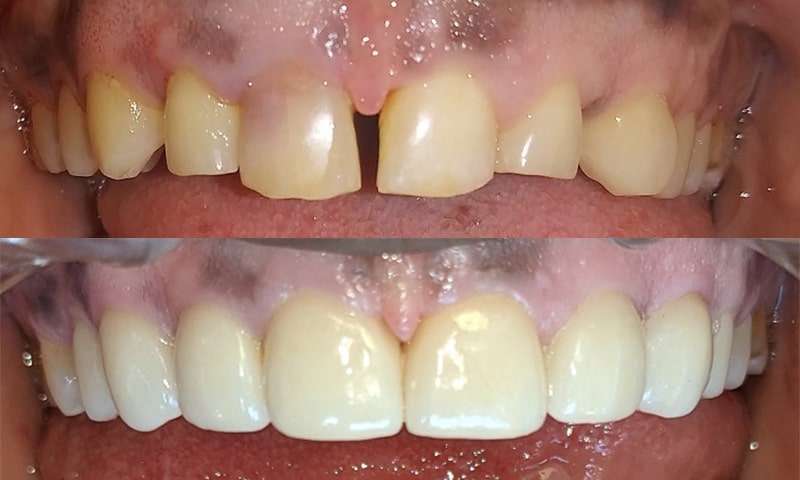
Esthetic Considerations
For highly esthetic cases, lithium disilicate has been shown to have improved esthetics, but with lower strength when compared to lithium disilicate. Thus for these highly esthetic cases, lithium disilicate may be a better option for a natural smile.
However if there are concerns about increased stress to the crown, such as in an anterior crossbite, zirconia may be a better material of choice even if it may not be as esthetic. These factors must be discussed with the providing dentist for the best resulting smile.
There are many factors that come into play when determining which material is going to be the best in which situation. There is not a universal material that is the best material in every scenario, although research is trying to produce one.
The clinical skills and judgement of the providing dentist also plays a role. Even with access to the best materials and techniques, there can be poor esthetic outcomes.
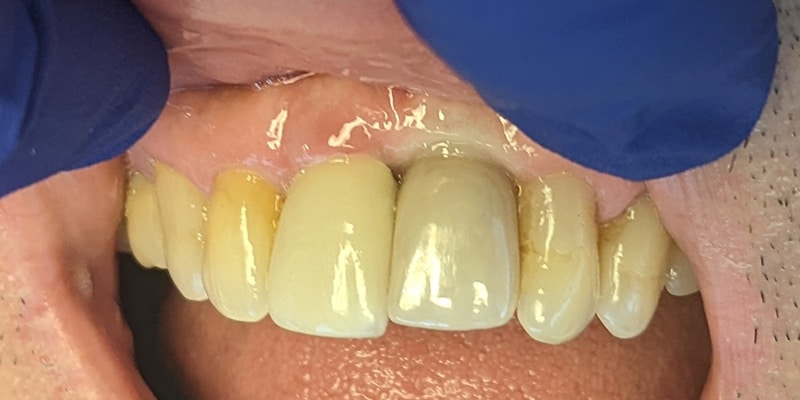
Strength Considerations
As a general rule of thumb, lithium disilicate is better in the anterior due to better esthetics and zirconia is better in the posterior due to better strength. However don’t be surprised if your dentist believes zirconia is better in the anterior or lithium disilicate in the posterior because there are many factors that come into play when deciding which material works best in each situation.
Time Considerations
The required number of visits for a porcelain crown procedure is independent of the material used. Instead reduced time and visits is factor of technology between each dental office. While every dentist can provide crown treatment, not every dental office and do the procedure in a single appointment. A mill is required to make the crown on site and skip the temporary crown step.
Cost of Ceramic Dental Crowns
Regardless of the material used, every style of ceramic crowns should cost the same. Dental offices typically do not have a different cost between a zirconia crown and a lithium disilicate crown. We covered the cost range of crowns in more detail, but have determined that general costs will be between $600 and $3,000, with most crowns being around $1,500, +/- $500.
In many insurance contracts, ceramic crowns cost slightly more than metal crowns but usually not more than a couple of hundred dollars. Be aware, there may also be varying surcharges for materials or highly esthetic cases.
Does Insurance Cover Ceramic Dental Crowns?
If your insurance covers dental crowns, then yes your insurance should cover ceramic crowns. However, there are other qualifications that must be met prior to insurance coverage:
- Remaining benefit. If you’ve maxed the yearly benefit, then your insurance company will not cover crowns or any additional treatment.
- Frequency. Insurance companies will cover crowns every so often. The range is usually between every 5-10 years, with every 7 years being common.
- If they don’t believe a crown is necessary. Insurance companies may not cover the crown if they don’t believe the crown was necessary and there is insufficient evidence to dispute the claim.
- If there is a missing tooth clause. While this only applies to implant crowns, if there is a missing tooth clause prior to replacing a missing tooth, your insurance company may not cover the implant crown.
Porcelain Crown Summary
Amongst the ceramic or porcelain crowns currently being employed, zirconia and lithium disilicate are the two most commonly used due to their superior properties when compared to the other generations of ceramics. Both can be used interchangeably in the front and back teeth. As technology and research into these materials continue to improve, it is possible that they will be the primary materials used when ceramics are involved.
This is not to say that metal crowns will be discontinued, but factors such as the cost of gold and other precious metals and decreased insurance reimbursements play a role in the utilization of each material. As these factors continue to impact clinical decisions, it is likely that those who receive metal crowns are those who specifically want metal crowns and not porcelain irrespective of insurance coverage and cost.
Regardless of the material, know that your dentist will choose a material that he or she believes will have the highest chance of long-term success. If you have further questions as to the reasons for the type of ceramic, ask your dentist and they will be able to explain.
Was this post helpful?
References
- 1
- 2
- 3
- 4
- 5
- 6
- 7


